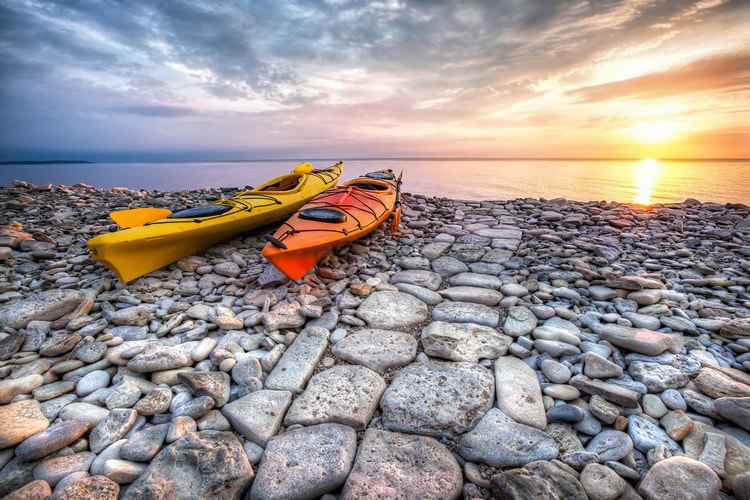A Guide to Taking Great Canoeing & Kayaking Shots
Canoeing and kayaking offer unique opportunities to capture great photographs – it will take you places you cannot go on foot. Balance issues and the movement of the water can make these shots tricky. But with some basic training on how to maneuver the watercraft and best use your equipment, you can nab some amazing images.
Let’s not forget that there is very limited space aboard a kayak or canoe. Ensuring you bring only the necessary gear and make it easily accessible is key to capturing interesting subjects and wildlife.

photo by Tim Martin
Practice the Rule of Thirds
Divide your image into thirds similar to a tic-tac-toe board. Use these intersections to separate your image into unequal parts.
This technique will help keep the focus of your subject on the lines and the intersections of the elements provide a natural backdrop for the photograph.
Capture Your Environment
A popular way to captures the panoramic beauty of your surroundings is to capture part of your kayak in the front of the frame and use the backdrop of the water to accentuate the photograph. Depending on whether you choose to emphasize the sky or water, direct your lens somewhere other than the middle of the horizon. Sunrises and sunsets offer optimal opportunities for majestic photographs from varying angles.
Direct Your Lens Toward a Close-up
When you are near the water, it is easy to focus on the landscape, but with patience, it is possible to hone in on an unforgettable element, whether it is a small ripple, sea life or the color of the water.
For a wide array of shots, interchange your angles and lens toward the external landscape and also focus on what is in front of you. A useful technique is to direct the lens toward the most important subject in your picture and blur the background.
Take Care of Your Equipment
Only go out in a quality canoe or kayak from a respected retailer. Cheap or poorly constructed water-crafts are more difficult to maneuver out on the water. And while on your kayak, be certain to tether your paddle to the boat and tie your camera to your life vest.
Periodically check the lens on your camera and wipe it with a microfiber cloth to ensure droplets won’t ruin the integrity of your picture.
Take Pictures From the Shoreline
Paddle to the shoreline to get a low perspective of the landscape. This allows an opportunity to capture other paddlers or offers a way to anchor yourself to the rocks for stills you may struggle with while you are moving on the water.
Taking Underwater & in-Water Photographs
For the ideal shots underwater, get close to your subject. Angle yourself low and shoot at an upward angle without putting your subject in the middle of your shot.
Put your camera in forced flash mode and set it to the highest resolution. For photographs of the water, try to create a splash and capture the droplets with your lens. For a mirror reflection of the water, the surface must be still and sunlight should not hit it directly.
I hope you enjoyed this article. Do you have more tips on shooting great images from a canoe or kayak?
Don’t forget that our ebook, Cameras in the Wild: A Guide for the Adventuring Photomaker, is out now! If you’re into adventure photography, this is the ebook to get! In it you will learn not only how to capture a strong photograph, but also how to develop your images so that they become polished manifestations of your unique vision.
